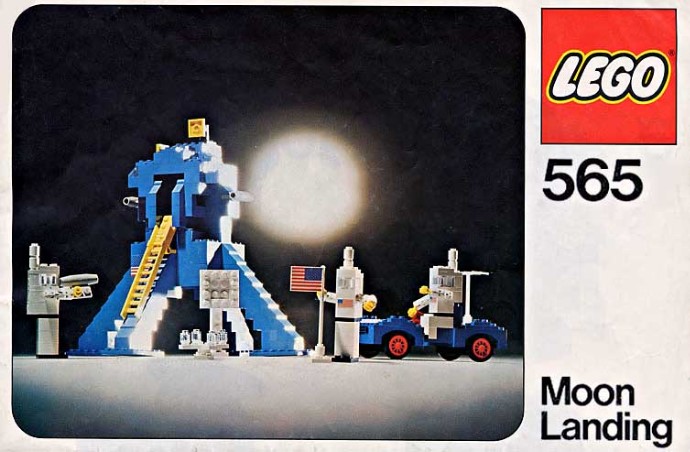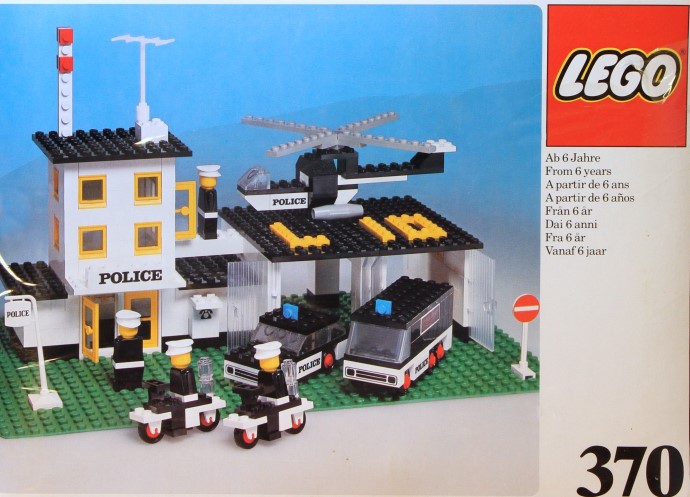Younger readers might not believe it, but the ubiquitous LEGO Minifigure hasn't always ruled the world. Some of us can remember a time before Minifigures ever existed. And during those dark, distant days, there was another, shorter-lived dynasty, that of the Maxi figures.
Prior to this, LEGO produced a series of Homemaker sets from 1971 onwards featuring domestic scenes such as a children's room and a kitchen. Early Homemaker sets were, to all intents and purposes, LEGO-built sections of a modular doll's house, albeit with something important missing - the dolls. I don't know whether LEGO always intended to remedy that situation, or whether poor sales and/or feedback from customers indicated that a change in direction was needed - if there are any experts out there then I'd love to know more of the history - but in 1974 the Homemaker sets started to be populated by figures. While predominantly brick-built, these figures featured a selection of brand new parts (below) - torsos, hands, heads and hair - enabling a degree of realism not previously possible with LEGO.
Constituents of a Homemaker Figure (pics from Bricklink)
The realism extended beyond just the appearance - the design of the figures meant that it was possible to rotate the head and move the arms at the shoulders, elbows and wrists. There was also variety - as you can see from the box shot of Set 200 LEGO Family above and the pictures of my LEGO family below, LEGO produced interchangeable heads for the figures with a variety of expressions, facial features (e.g. freckles) and even spectacles. There were also different hair pieces, again interchangeable, and the torsos and arms were available in a variety of colours.
As far as I can make out, LEGO produced around 60 sets between 1974 and 1982 containing one or more of these Homemaker figures. The sets were predominantly domestic scenes, but also included a few vehicles and basic sets. One interesting twist to the formula can be seen in Set 565 Moon Landing (below) which replaced the Homemaker head with blocky brick-built space helmets.
.jpg) |
| Set 212 Scooter |
.jpg) |
| Set 265 Bathroom |
Truth be told, despite the early success of Homemaker figures, they were an endangered species almost as soon as they were born. Barely a year after they first started to appear in sets, a smaller, simpler type of figure was born. This ancestor of the modern minifigure (below) first started appearing in sets in 1975. Lacking any facial features or poseable arms or hands, these figures must have seemed incredibly rudimentary compared with the Homemaker figures, and it's incredible to believe that they nevertheless set the wheels in motion for the modern phenomenon that is the minifigure.
It took only 3 years for the early minifigures to evolve into their modern form, and in 1978, the minifigure credited with being the first of the modern breed appeared in Set 600 Police Car. The rest, as they say, is history, but let's never forget the little people who arguably kickstarted the whole minifigure revolution....
.jpg) |
| Early minifigure, from Set 664 TV Crew |
Simple they may have been, but some of my favourite childhood sets, such as Set 370 Police Headquarters, featured these early prototypal minifigures. It may be that one of the reasons why these smaller figures ended up ousting the Homemakers is down to scale; a Homemaker-compatible police station, for instance, would have needed to be considerably larger and consequently more expensive than Set 370, and it's likely that the adoption of smaller figures opened up more possibilites in terms of what sets were feasible.


.jpg)
.jpg)
.jpg)


.jpg)
Great post and very informative. I remember having a quite a few of these figures in our big box of LEGO while growing up.
ReplyDeleteI enjoy reading your blog. Great post and again, very informative. I never had any homemaker figures myself until recently when I purchased them on eBay. They are almost perfectly to scale with the recent 10220 VW T1 camper van.
ReplyDeleteInteresting - I didn't realise the Homemakers are to scale with the Camper, but makes sense. I like the idea of pairing retro figures with a retro design !
DeleteInteresting post, thanks. I wonder whether any of the homemaker pieces have been put to good use in a decent modern MOC?
ReplyDeleteGood question - if they have, I've not seen them. That having been said, joining multiple arm segments together and attaching them to torso pieces would make some pretty mean tentacles !
DeleteGreat post Dave. Despite their yellowness I've seen maxifig hands used in MOCs quite a bit, but of course can't find any now!
DeleteBut on the Homemaker shizzle, I did come across this recently. Beautiful reworking of 212. http://www.flickr.com/photos/40543176@N03/6164546404/
(His other stuff is definitely work a look too. Wish I could build like that!)
I still have that set 200 with box and instructions too! Also have that police set, dude could never ride in is car :(
ReplyDeleteThere was also another figure type, scaled somewhere between the homemakers and the minifigs. Haven't been able to find much about it. I think they must only have been on the market for a very short while.
ReplyDeleteOK, I found out something finally about this midi-figure type. Apparently it is known as a 'finger puppet' or a 'basic figure', and appeared in two styles, boy and girl. Part numbers 4224c01 and 4224c02, usually in starter sets.
DeleteThey have no arms, or legs. Body is one 4x4 (like the homemakers) but with smaller heads and non-detachable hair. Rather sweet.